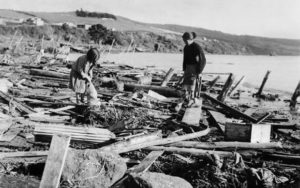By Nurul Islam Laskar
 I was born in Shillong, then capital of undivided Assam state of India, on June 18, 1950. Later Shillong became the capital of Meghalaya. Meghalaya was formed by carving out two districts from the state of Assam: the United Khasi Hills and the Garo Hills on January 21, 1972.
I was born in Shillong, then capital of undivided Assam state of India, on June 18, 1950. Later Shillong became the capital of Meghalaya. Meghalaya was formed by carving out two districts from the state of Assam: the United Khasi Hills and the Garo Hills on January 21, 1972.
My birth was not an earth-shaking event. But in less than two months after my birth something that happened was indeed earth-shaking. The 1950 Assam-Tibet earthquake, also known as the Assam earthquake occurred on August 15, India’s fourth Independence Day, that had a moment magnitude of 8.6 on the Richter scale.
My father, Kutub Ali Laskar, worked at the office of the Inspector General of Police (IGP), Assam in those days. We lived in a rented house in the Laitumkhrah area of Shillong. I was too young to remember anything about the August 1950 earthquake and its impact over Shillong. But my parents told me that the earthquake came in the evening, between 7.30 and 8.00pm IST. Our house was not damaged. But the aftershocks kept coming for over eight months after the main earthquake. People were unable to sleep peacefully at night. On the lighter side, when an aftershock came at midnight, people came running out of their houses on the streets. Later when the tremor stopped, many found themselves not properly attired for a public appearance! They went back running to their houses.
 With its epicentre in the Mishmi Hills, known in Chinese as the Qilingong mountains, south of the Kangri Garpo and just east of the Himalayas in the North East Frontier Agency (NEFA), India. This area, south of the McMahon Line and now known as Arunachal Pradesh, an integral part of India over which China keeps laying its claims from time to time. Occurring on a Tuesday evening, the earthquake was destructive in both Assam (India) and Tibet (China), and it is estimated that 4,800 people lost their life in it. The earthquake is notable as being the largest recorded quake caused by continental collision rather than subduction, and is also notable for the loud noises produced by the quake and reported throughout the region. It was recorded as the sixth largest earthquake of the 20th century.
With its epicentre in the Mishmi Hills, known in Chinese as the Qilingong mountains, south of the Kangri Garpo and just east of the Himalayas in the North East Frontier Agency (NEFA), India. This area, south of the McMahon Line and now known as Arunachal Pradesh, an integral part of India over which China keeps laying its claims from time to time. Occurring on a Tuesday evening, the earthquake was destructive in both Assam (India) and Tibet (China), and it is estimated that 4,800 people lost their life in it. The earthquake is notable as being the largest recorded quake caused by continental collision rather than subduction, and is also notable for the loud noises produced by the quake and reported throughout the region. It was recorded as the sixth largest earthquake of the 20th century.
Its aftershocks were numerous, many of them were of magnitude 6.00 and over, and well enough recorded at distant locations for reasonably good epicentre location. Besides loss of life and property, alterations of relief were brought about by many rock falls in the Mishmi Hills and surrounding forested regions.
All said and done, the great earthquake of 1950 brought the north east to limelight as it shattered the region in socio-economic field. The realisation for construction of earthquake-resistant roads, bridges and buildings also dawned in the minds of the people.
[The author was a columnist in the 80s & 90s and now a contributor at The Shillong Times]



